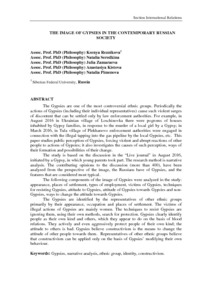The image of gypsies in the contemporary Russian society
URI (для ссылок/цитирований):
https://sgemworld.at/ssgemlib/spip.php?article3904https://elib.sfu-kras.ru/handle/2311/69657
Автор:
Резникова Ксения Вячеславовна, Ksenya Reznikova
Середкина Наталья Николаевна, Natalia Seredkina
Замараева Юлия Сергеевна, Julia Zamaraeva
Кистова Анастасия Викторовна, Anastasiya Kistova
Пименова Наталья Николаевна, Natalia Pimenova
Коллективный автор:
Гуманитарный институт
Кафедра культурологии
Дата:
2017-03Журнал:
4th International Multidisciplinary Scientific Conference on Social Sciences and Arts SGEM2017Квартиль журнала в Web of Science:
без квартиляБиблиографическое описание:
Резникова Ксения Вячеславовна, Ksenya Reznikova. The image of gypsies in the contemporary Russian society [Текст] / Ksenya Reznikova Резникова Ксения Вячеславовна, Natalia Seredkina Середкина Наталья Николаевна, Julia Zamaraeva Замараева Юлия Сергеевна, Anastasiya Kistova Кистова Анастасия Викторовна, Natalia Pimenova Пименова Наталья Николаевна // 4th International Multidisciplinary Scientific Conference on Social Sciences and Arts SGEM2017. — 2017. — С. 1007-1012Аннотация:
The Gypsies are one of the most controversial ethnic groups. Periodically the actions of Gypsies (including their individual representatives) cause such violent surges of discontent that can be settled only by law enforcement authorities. For example, in August 2016 in Ukrainian village of Loschinovka there were pogroms of houses inhabited by Gypsy families, in response to the murder of a local girl by a Gypsy; in March 2016, in Tula village of Plekhanovo enforcement authorities were engaged in connection with the illegal tapping into the gas pipeline by the local Gypsies, etc. This paper studies public perception of Gypsies, forcing violent and abrupt reactions of other people to actions of Gypsies; it also investigates the causes of such perception, ways of their formation and possibilities of their change.
The study is based on the discussion in the “Live journal” in August 2016, initiated by a Gypsy, in which young parents took part. The research method is narrative analysis. The contributing opinions to the discussion (more than 400), have been analyzed from the perspective of the image, the Russians have of Gypsies, and the features that are considered most typical.
The following components of the image of Gypsies were analyzed in the study: appearance, places of settlement, types of employment, victims of Gypsies, techniques for resisting Gypsies, attitude to Gypsies, attitude of Gypsies towards Gypsies and non-Gypsies, ways to change the attitude towards Gypsies.
The Gypsies are identified by the representatives of other ethnic groups primarily by their appearance, occupation and places of settlement. The victims of illegal actions of Gypsies are mainly women. The techniques to resist Gypsies are ignoring them, using their own methods, search for protection. Gypsies clearly identify people as their own kind and others, which they appear to do on the basis of blood relations. They actively and even aggressively protect people of their own kind; the attitude to others is bad. Gypsies believe constructivism is the means to change the attitude of other people towards them. Representatives of other ethnic groups believe that constructivism can be applied only on the basis of Gypsies' modifying their own behaviour.

